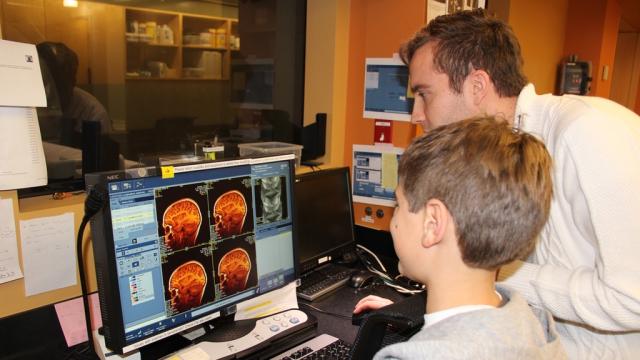Neuroscienitsts have generally thought that babies are born with more tissue than their brains need, and that the body slowly dumps some of it as the brain develops. However, a new study shows that at least one part of the brain — the part that recognises faces — appears to develop in the opposite direction, increasing in complexity into adulthood.
Image: Jesse Gomez and Kalanit Grill-Spector at the Vision and Perception Neuroscience Lab
In research published this week in the journal Science, an international team of neuroscientists sought to understand the complex process of brain development. To do so, they analysed the brains of a group of kids and adults with advanced MRI techniques, delivering face and place recognition tests to their subjects. The results showed more structural complexity in certain parts of the brain in the adults than in children, matching improvements in the subjects’ ability to recognise faces — something that surprised even the study’s authors.
“When I learned about the brain, we were told we were born with more than they need at birth and the tissue gets pruned away,” said Jesse Gomez, a Stanford PhD student in neuroscience and the study’s first author. “It was really surprising to see that what’s left is growing and impacts the brain’s function.”
The experiments included 22 children between the ages of five and 12, and 25 adults between the ages of 22 and 28. After training the fidgety children to sit still in a mock brain scanner, the researchers performed a functional MRI and quantitative MRI scan on each subject and delivered a series of tests to measure how good the subjects were at completing various perceptual tasks. The functional MRI produced images showing which areas of the brain lit up when subjects performed specific tasks, while the quantitative MRI provided numerical measurements of brain tissue properties, allowing the researchers to compare values between subjects, said Gomez. They validated the measurements of the adults’ brain activities with scans of the microscopic structure of adult post-mortem brain tissue.
The scientists found that the older subjects had more complexity in their brains’ supporting structure, in a part of the brain called the fusiform gyrus. This occurred specifically the region that recognises faces, and not in the nearby region that recognises places. The adults didn’t have more neurons or bigger regions — rather, Gomez compared the results to a fixed-size garden plot with more flowers, roots and branches in the adult group.
The results impressed other scientists as well. “I haven’t seen a study using [the quantitative MRI] technique in kids before,” Kevin Pelphrey, neuroscientist and director of the Autism and Neurodevelopmental Disorders Institute at George Washington University, told Gizmodo. “It’s a nice combination of methodologies in a brain and behavioural development study around face processing.”
Pelphrey cautioned against making big assumptions about brain development in the individual subjects, though. That would require bringing the subjects in multiple times over the course of several years, which, according to the study’s principal investigator Kalanit Grill-Spector, is something that’s definitely being considered.
Pelphrey also would have liked to see more subjects in the results, but Grill-Spector countered that the sample size was large for the amount of work that went into the study, including training and bringing almost 50 people into the lab multiple times. “It was a very intense effort. We would love to have a larger sample size, but I don’t think it’s the main limitation of the study,” she said. Instead, she thought the biggest limitation was that they were able to validate their MRI measurements with detailed scans of adult post-mortem brain, but not children’s brains. The more detailed imaging techniques require slices of brain tissue, so it can’t be done on living subjects. “It’s very difficult to obtain post-mortem brains,” she said. “Even more so in children.”
Ultimately, Pelphrey was most excited about the idea that facial recognition could continue to develop as we age, an insight that could lead to a better understanding of why face processing abilities differ between people. It also implied to him that in cases of abnormal development of functions like facial recognition, or in diseases like autism and schizophrenia, doctors may be able to intervene later than previously thought.
To Gomez, the most exciting result came at the most basic level: “It shows that a change in brain function might require a change in the brain’s structure.”
[Science]
